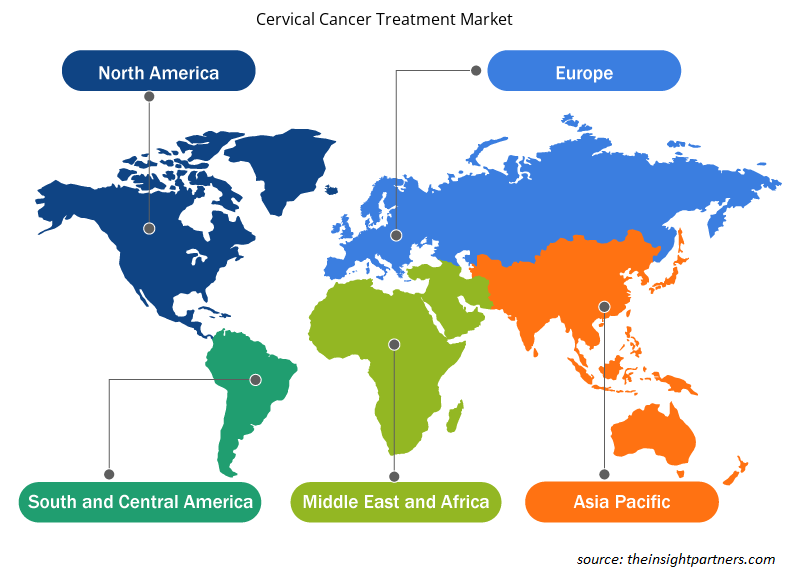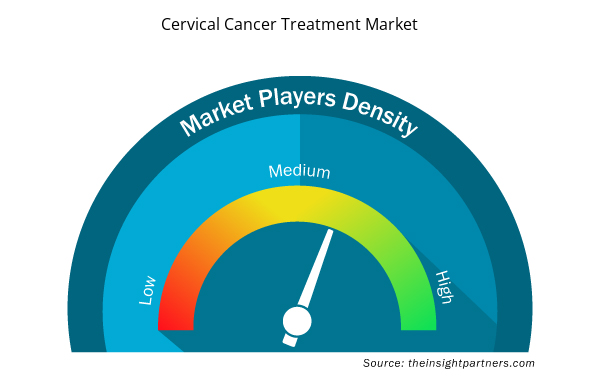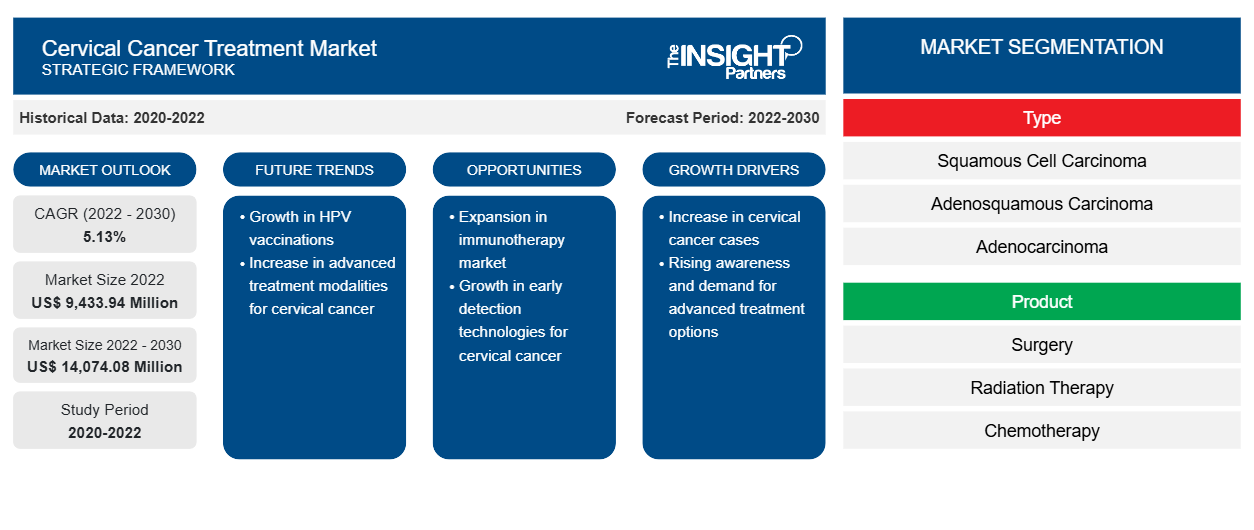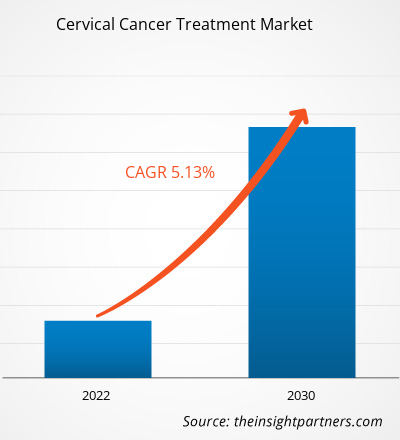[調査レポート] 子宮頸がん治療市場は、2022年の94億3,394万米ドルから2030年には140億7,408万米ドルに成長すると予測されており、2022年から2030年にかけて5.13%のCAGRを記録すると予想されています。
市場洞察とアナリストの見解:
子宮頸がん治療市場の予測 は、関係者が成長戦略を計画するのに役立ちます。
子宮頸がんは、子宮頸部、つまり膣につながる子宮の下部の細胞に発生するがんを指します。症例の 90% では、子宮頸部の悪性腫瘍は HPV 感染によって発生し、塗抹標本検査によって診断されます。子宮頸がんの罹患率の増加と HPV 感染の増加は、子宮頸がん治療市場の成長を牽引する主な要因です。しかし、診断と治療法に関する認識の欠如が市場の成長を妨げています。子宮頸がん治療市場の動向には、子宮頸がんの診断と治療薬の研究開発の増加が含まれます。
成長の原動力と課題:
子宮頸がん罹患率の増加が子宮頸がん治療市場を活性化
世界中で、がんは死亡の主な原因の1つになりつつあります。世界保健機関(WHO)によると、がんは183か国で70歳未満の人の死因の第1位であり、他の123か国では2019年に世界で4番目に多い死因でした。さらに、世界保健機関が2021年3月に発表したデータによると、2020年にはさまざまな形態のがんが原因で1,000万人近くが死亡しました。検討中の市場は大幅な拡大を示しており、これは世界中の女性の間で子宮頸がんの発生頻度が上昇していることに関係している可能性があります。世界保健機関(WHO)によると、子宮頸がんは毎年27万人以上の女性の命を奪っています。子宮頸がんの死亡率は、病気の発見が遅れるため、貧しい国では高くなっています。
子宮頸がんの罹患率の増加は、世界中の医療システムに負担をかけています。国際がん研究機関 (IARC) によると、世界の新規がん症例の負担は約 2,750 万人に達すると推定され、2040 年までにこの疾患による死亡者数は約 1 億 6,300 万人に達すると見込まれています。ライフスタイルの変化、喫煙、身体活動の減少、健康状態や気候条件の不確実性などの要因により、今後数年間で世界のがんの負担が増加すると予想されています。したがって、世界中で増加するがんを抑制し、予防することが不可欠です。
子宮頸がんに関する国民、医療提供者、政策立案者の間での認識不足、質の高い医療サービスや子宮頸部検診プログラムへのアクセスの制限、機能的な紹介システムの欠如などが、子宮頸がんの発症率と死亡率の高さにつながる要因の一部です。子宮頸がんの発症率と死亡率は、細胞学的検診へのアクセスの改善と早期子宮頸部病変の迅速な治療により、先進国では低下しています。子宮頸がんによる死亡率を下げるには、人口ベースの子宮頸部検診を実施し、低中所得国(LMIC)での受け入れを増やすことが重要です。若年での初性交や男性の性的パートナーが複数いること、HPV 8、9、10型に関連する高いリスク、若年での初妊娠、経口避妊薬の長期使用、 HIV感染などのリスク要因に関する認識を高めることは、検診プログラムへの参加を促進するのに役立つ可能性があります。月経中期の膣出血、閉経後の膣出血、性交後の膣出血、膣分泌物の悪臭、下腹部の痛みなど、子宮頸がんの症状に関する認識を高めることで、女性が早期に助けを求めることができるようになるかもしれません。したがって、子宮頸がんに対する国民の認識不足は、子宮頸がん治療市場の成長を妨げています。
要件に合わせてレポートをカスタマイズする
このレポートの一部、国レベルの分析、Excelデータパックなど、あらゆるレポートを無料でカスタマイズできます。また、スタートアップや大学向けのお得なオファーや割引もご利用いただけます。
- このレポートの主要な市場動向を入手してください。この無料サンプルには、市場動向から見積もりや予測に至るまでのデータ分析が含まれます。
レポートのセグメンテーションと範囲:
セグメント分析:
タイプに基づいて、市場は扁平上皮癌、腺扁平上皮癌、および腺癌に分類されます。扁平上皮癌セグメントは、2022年に子宮頸がん治療の市場シェアが大きく、2022年から2030年の間に高いCAGRを記録すると予想されています。製品に基づいて、市場は手術、放射線療法、化学療法、免疫療法、および治療用ワクチンに分類されます。手術セグメントは、2030年までに大きなシェアを占めると予想されます。エンドユーザーの観点から、市場は病院、在宅ケア、がんセンターなどに分類されます。エンドユーザーの観点から、病院セグメントは2022年に最大の子宮頸がん治療市場シェアを占めました。
地域分析:
地理的に見ると、子宮頸がん治療市場レポートの範囲は、北米、ヨーロッパ、アジア太平洋、中東およびアフリカ、南米および中米に及びます。北米は2022年に最大の子宮頸がん治療市場シェアを占めました。北米では、米国が大きなシェアを占めています。継続的に進行中の研究開発活動、政府やその他の公的機関および民間組織からの財政支援、IT企業と製薬企業のパートナーシップ、神経疾患の発生率の上昇が、主にこの国の市場成長を牽引しています。さらに、政府が検査手順を改善するために講じた戦略的取り組みは、予測期間中に市場に利益をもたらすと予想されます。希少疾患に関する規制の採用が増えることは、市場拡大の機会となる可能性が高いでしょう。たとえば、米国がん協会(ACS)は、2020年9月に子宮頸がんのスクリーニング基準を改訂しました。
子宮頸がん治療市場の地域別分析
予測期間を通じて子宮頸がん治療市場に影響を与える地域的な傾向と要因は、Insight Partners のアナリストによって徹底的に説明されています。このセクションでは、北米、ヨーロッパ、アジア太平洋、中東、アフリカ、南米、中米にわたる子宮頸がん治療市場のセグメントと地理についても説明します。

- 子宮頸がん治療市場の地域別データを入手
子宮頸がん治療市場レポートの範囲
| レポート属性 | 詳細 |
|---|---|
| 2022年の市場規模 | 94億3,394万米ドル |
| 2030年までの市場規模 | 140億7,408万米ドル |
| 世界のCAGR(2022年 - 2030年) | 5.13% |
| 履歴データ | 2020-2022 |
| 予測期間 | 2022-2030 |
| 対象セグメント | タイプ別
|
| 対象地域と国 | 北米
|
| 市場リーダーと主要企業プロフィール |
|
子宮頸がん治療市場のプレーヤー密度:ビジネスダイナミクスへの影響を理解する
子宮頸がん治療市場は、消費者の嗜好の変化、技術の進歩、製品の利点に対する認識の高まりなどの要因により、エンドユーザーの需要が高まり、急速に成長しています。需要が高まるにつれて、企業は提供を拡大し、消費者のニーズを満たすために革新し、新たなトレンドを活用し、市場の成長をさらに促進しています。
市場プレーヤー密度とは、特定の市場または業界内で活動している企業または会社の分布を指します。これは、特定の市場スペースに、その市場規模または総市場価値に対してどれだけの競合相手 (市場プレーヤー) が存在するかを示します。
子宮頸がん治療市場で事業を展開している主要企業は次のとおりです。
- F.ホフマン・ラ・ロシュ株式会社
- メルクシャープ
- ドーム株式会社
- グラクソ・スミスクライン
- ジェネンテック株式会社
免責事項:上記の企業は、特定の順序でランク付けされていません。

- 子宮頸がん治療市場のトップキープレーヤーの概要を入手
業界の発展と将来の機会:
子宮頸がん治療市場の分析は、市場で活動している主要企業を特定し評価することによって行われます。主要な市場企業が行っている取り組みのいくつかを以下に示します。
- 2024年1月、ファイザー社とジェンマブ社は、米国食品医薬品局(FDA)が、一次治療中または治療後に病状が進行した再発性または転移性子宮頸がん患者の治療薬としてTIVDAK(チソツマブ ベドチン-TFTV)の承認を変更するための補足生物学的製剤承認申請(sBLA)を受理したことを発表しました。処方薬ユーザーフィー法(PDUFA)の目標日は2024年5月9日であり、この申請は優先審査に指定されています。
- 2023年9月、広州グロリアバイオサイエンス(GloriaBio)は、完全ヒト抗PD-1モノクローナル抗体であるジンベレリマブ注射剤(YuTuo、GLS-010)が中国国家薬品監督管理局(NMPA)により販売承認されたと発表しました。この注射剤は、再発性または転移性子宮頸がん(R/M CC)患者の治療に単剤療法として使用できます。子宮頸がんの治療薬として世界で承認された3番目の免疫チェックポイント阻害剤(ICI)抗体はジンベレリマブであり、中国で承認された最初で唯一のものです。
競争環境と主要企業:
F. Hoffmann-La Roche Ltd、Merck Sharp、Dohme Corp.、GlaxoSmithKline plc.、Genentech Inc.、Amgen Inc.、Advaxis Inc.、Biocon、Allergan Inc.、Pfizer Inc.、およびAstraZenecaは、子宮頸がん治療市場レポートで紹介されている主要企業の一部です。これらの企業は、世界中で高まる消費者の需要を満たすために、提供内容の拡大に注力しています。グローバルなプレゼンスにより、多くの顧客にサービスを提供でき、その結果、市場でのプレゼンスを拡大できます。
- 過去2年間の分析、基準年、CAGRによる予測(7年間)
- PEST分析とSWOT分析
- 市場規模価値/数量 - 世界、地域、国
- 業界と競争環境
- Excel データセット



Report Coverage
Revenue forecast, Company Analysis, Industry landscape, Growth factors, and Trends

Segment Covered
This text is related
to segments covered.

Regional Scope
North America, Europe, Asia Pacific, Middle East & Africa, South & Central America

Country Scope
This text is related
to country scope.
よくある質問
The cervical cancer treatment market is expected to be valued at US$ 14,074.08 million in 2030.
Based on type, the cervical cancer treatment market is segmented into squamous cell carcinoma, adenosquamous carcinoma, and adenocarcinoma. The squamous cell carcinoma segment held a larger cervical cancer treatment market share in 2022 and is anticipated to register a higher CAGR during 2022–2030.
The cervical cancer treatment market was valued at US$ 9,433.94 million in 2022.
Based on product, the market is divided into surgery radiation therapy, chemotherapy, immunotherapy, and therapeutic vaccines..
Cervical cancer refers to the cancer that occurs in the cells of the cervix, i.e., the lower part of the uterus that connects to the vagina. In 90% of the cases, cervical malignancies occur due to the HPV infection and are diagnosed through smear screening.
The increasing prevalence of cervical cancer and the rise in HPV infections are the key factors driving the cervical cancer treatment market growth. However, the lack of awareness about the diagnosis and treatment methods hampers the growth of the market. Cervical cancer treatment market trends include the increasing R&D for cervical cancer diagnosis and drugs
The cervical cancer treatment market has major market players, including F. Hoffmann-La Roche Ltd, Merck Sharp, Dohme Corp., GlaxoSmithKline plc., Genentech Inc., Amgen Inc., Advaxis Inc., Biocon, Allergan Inc., Pfizer Inc., and AstraZeneca.
Trends and growth analysis reports related to Life Sciences : READ MORE..
The List of Companies - Cervical Cancer Treatment Market
- F. Hoffmann-La Roche Ltd
- Merck Sharp
- Dohme Corp.
- GlaxoSmithKline plc.
- Genentech, Inc.
- Amgen Inc.
- Advaxis, Inc.
- Biocon
- Allergan, Inc
- Pfizer Inc
- AstraZeneca
The Insight Partners performs research in 4 major stages: Data Collection & Secondary Research, Primary Research, Data Analysis and Data Triangulation & Final Review.
- Data Collection and Secondary Research:
As a market research and consulting firm operating from a decade, we have published and advised several client across the globe. First step for any study will start with an assessment of currently available data and insights from existing reports. Further, historical and current market information is collected from Investor Presentations, Annual Reports, SEC Filings, etc., and other information related to company’s performance and market positioning are gathered from Paid Databases (Factiva, Hoovers, and Reuters) and various other publications available in public domain.
Several associations trade associates, technical forums, institutes, societies and organization are accessed to gain technical as well as market related insights through their publications such as research papers, blogs and press releases related to the studies are referred to get cues about the market. Further, white papers, journals, magazines, and other news articles published in last 3 years are scrutinized and analyzed to understand the current market trends.
- Primary Research:
The primarily interview analysis comprise of data obtained from industry participants interview and answers to survey questions gathered by in-house primary team.
For primary research, interviews are conducted with industry experts/CEOs/Marketing Managers/VPs/Subject Matter Experts from both demand and supply side to get a 360-degree view of the market. The primary team conducts several interviews based on the complexity of the markets to understand the various market trends and dynamics which makes research more credible and precise.
A typical research interview fulfils the following functions:
- Provides first-hand information on the market size, market trends, growth trends, competitive landscape, and outlook
- Validates and strengthens in-house secondary research findings
- Develops the analysis team’s expertise and market understanding
Primary research involves email interactions and telephone interviews for each market, category, segment, and sub-segment across geographies. The participants who typically take part in such a process include, but are not limited to:
- Industry participants: VPs, business development managers, market intelligence managers and national sales managers
- Outside experts: Valuation experts, research analysts and key opinion leaders specializing in the electronics and semiconductor industry.
Below is the breakup of our primary respondents by company, designation, and region:

Once we receive the confirmation from primary research sources or primary respondents, we finalize the base year market estimation and forecast the data as per the macroeconomic and microeconomic factors assessed during data collection.
- Data Analysis:
Once data is validated through both secondary as well as primary respondents, we finalize the market estimations by hypothesis formulation and factor analysis at regional and country level.
- Macro-Economic Factor Analysis:
We analyse macroeconomic indicators such the gross domestic product (GDP), increase in the demand for goods and services across industries, technological advancement, regional economic growth, governmental policies, the influence of COVID-19, PEST analysis, and other aspects. This analysis aids in setting benchmarks for various nations/regions and approximating market splits. Additionally, the general trend of the aforementioned components aid in determining the market's development possibilities.
- Country Level Data:
Various factors that are especially aligned to the country are taken into account to determine the market size for a certain area and country, including the presence of vendors, such as headquarters and offices, the country's GDP, demand patterns, and industry growth. To comprehend the market dynamics for the nation, a number of growth variables, inhibitors, application areas, and current market trends are researched. The aforementioned elements aid in determining the country's overall market's growth potential.
- Company Profile:
The “Table of Contents” is formulated by listing and analyzing more than 25 - 30 companies operating in the market ecosystem across geographies. However, we profile only 10 companies as a standard practice in our syndicate reports. These 10 companies comprise leading, emerging, and regional players. Nonetheless, our analysis is not restricted to the 10 listed companies, we also analyze other companies present in the market to develop a holistic view and understand the prevailing trends. The “Company Profiles” section in the report covers key facts, business description, products & services, financial information, SWOT analysis, and key developments. The financial information presented is extracted from the annual reports and official documents of the publicly listed companies. Upon collecting the information for the sections of respective companies, we verify them via various primary sources and then compile the data in respective company profiles. The company level information helps us in deriving the base number as well as in forecasting the market size.
- Developing Base Number:
Aggregation of sales statistics (2020-2022) and macro-economic factor, and other secondary and primary research insights are utilized to arrive at base number and related market shares for 2022. The data gaps are identified in this step and relevant market data is analyzed, collected from paid primary interviews or databases. On finalizing the base year market size, forecasts are developed on the basis of macro-economic, industry and market growth factors and company level analysis.
- Data Triangulation and Final Review:
The market findings and base year market size calculations are validated from supply as well as demand side. Demand side validations are based on macro-economic factor analysis and benchmarks for respective regions and countries. In case of supply side validations, revenues of major companies are estimated (in case not available) based on industry benchmark, approximate number of employees, product portfolio, and primary interviews revenues are gathered. Further revenue from target product/service segment is assessed to avoid overshooting of market statistics. In case of heavy deviations between supply and demand side values, all thes steps are repeated to achieve synchronization.
We follow an iterative model, wherein we share our research findings with Subject Matter Experts (SME’s) and Key Opinion Leaders (KOLs) until consensus view of the market is not formulated – this model negates any drastic deviation in the opinions of experts. Only validated and universally acceptable research findings are quoted in our reports.
We have important check points that we use to validate our research findings – which we call – data triangulation, where we validate the information, we generate from secondary sources with primary interviews and then we re-validate with our internal data bases and Subject matter experts. This comprehensive model enables us to deliver high quality, reliable data in shortest possible time.


 このレポートの無料サンプルを入手する
このレポートの無料サンプルを入手する